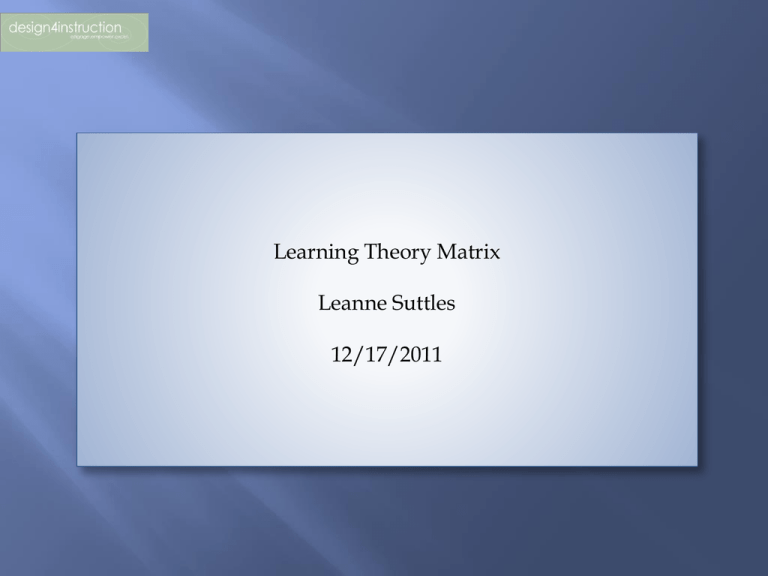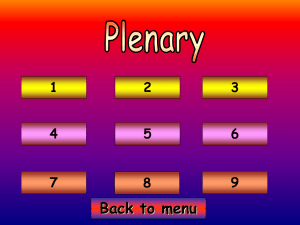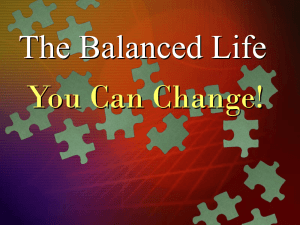Learning Theory Matrix
advertisement

Learning Theory Matrix Leanne Suttles 12/17/2011 Behaviorist Theory Cognitive Theory Constructivist Theory Social Learning Theory Connectivism Adult Learning How Does Learning Occur? How Does Learning Occur? How Does Learning Occur? How Does Learning Occur? How Does Learning Occur? How Does Learning Occur? What Factors influence learning? What Factors influence learning? What Factors influence learning? What Factors influence learning? What Factors influence learning? What Factors influence learning? What is the role of memory? What is the role of memory? What is the role of memory? What is the role of memory? What is the role of memory? What is the role of memory? How does transfer occur? How does transfer occur? How does transfer occur? How does transfer occur? How does transfer occur? How does transfer occur? What types of learning are best explained by this theory? What types of learning are best explained by this theory? What types of learning are best explained by this theory? What types of learning are best explained by this theory? What types of learning are best explained by this theory? What types of learning are best explained by this theory? How is technology How is technology How is technology How is technology How is technology How is technology used for learning in used for learning in used for learning in used for learning in used for learning in used for learning in your industry? your industry? your industry? your industry? your industry? your industry? Behaviorism: Learning is “changes in either the form or frequency of observable behavior (Ertmer & Newby, 1993).” (Byrne, 2011) Learning occurs when •a proper response follows a specific stimulus. •The response must be observable. Associations are made with consequences and reinforcements. •the instructor is responsible for learning to occur. (Byrne, How Does Learning Occur? 2011) Main Menu Behaviorism: What Factors Influence Learning? A Stimulus is presented. If a proper Response is given, then learning occurs. When a response is followed by reinforcement, the response is likely to occur again. (Byrne, 2011) Main Menu Memory is not addressed in Behaviorism, because it is not observable. (Byrne, 2011) Main Menu Behaviorism: How Does Transfer Occur? •Transfer is the result of generalizations. •The learner must be presented with situations that involve identical or similar features. (Pearson, 2010) Main Menu Behaviorism (Pearson, 2011) Discrimination • Recalling facts Generalizations What types of learning are best explained by Behaviorism? • Defining and illustrating concepts Associations • Applying explanations Chaining • Automatically performing a specified feature Main Menu Drill and Practice (Green, 09) Main Menu Cognitivism: How Does Learning Occur? •Mental Activity: Internal coding and structuring by the learner •Change occurs in state of knowledge (Gunderson, 2009) Main Menu Cognitivism: What factors influence learning? Environmental Practice conditions with corrective feedback Processes of mental planning, goal-setting, and organizational strategies The way learners attend to, code, transform, rehearse, store and retrieve information Learners’ thoughts, beliefs, attitudes, and values (Peggy A. Ertmer, 1993) Main Menu Cognitivism: What is the Role of Memory? Information The is organized and stored in a meaningful manner Learner needs to relate new information to prior knowledge (Peggy A. Ertmer, 1993) Main Menu Cognitivism: How Does Transfer Occur? Transfer occurs when the learner understands how to apply knowledge in different contexts (Peggy A. Ertmer, 1993) Main Menu What Types of Learning are Best Explained by Cognitivism? Complex •reasoning •problem-solving •information processing Communicate & Transfer knowledge in an efficient manner: •simplify •standardize : analyze- decompose- simplify into basic building blockseliminate irrelevant information (Peggy A. Ertmer, 1993) Main Menu •Arrange practice with feedback so new information is effectively and efficiently assimilated or accommodated with the learner’s cognitive structure •Webs give students immediate feedback according to the information being requests. Students are able to express ideas in their own words thereby allowing them to connect assimilate the information according to their own cognitive structure oConnect new information to prior knowledge oExample: K-W-L charts allow students to make personal and meaningful connections to their prior experience Main Menu Constructivism: How Does Learning Occur? Learning is an active process of creating meaning from different experiences. (Kim, 2001) Main Menu Constructivism: What Factors Influence Learning? The Learner Learning Environment (Kim, 2001) (Kim, 2001) Ability to construct knowledge Memory Ability to connect new information to prior knowledge Main Menu Constructivism: How Does Transfer Occur? (Abbot, 2010) ability to process knowledge connect to prior experiences Transfer Main Menu What Types of Learning are best explained by Constructivism? (Abbot, 2010) LearnerCentered Instruction Creating meaning and knowledge Constructivism: Types of Learning Reflect and make connections with prior knowledge Hypothesize, question, investigate, imagine, invent Main Menu Communication Create and Record Information Access and Retrieve Information Main Menu Social Learning Theory: How Does Learning Occur? (Pearson, 2010) Main Menu Attention Retention Motor Reproduction Motivation Main Menu Memory Modeling Observation Main Menu The Learner makes generalizations The Learner recognizes similarities of the new stimuli Main Menu Social Skills Athletic Skills Appropriate Social & Emotional Behavior Attitudes Values & Morality Main Menu The use of technology, within the Social Learning Theory, is a Constructivist approach. Learners construct meaning through experience. Learning is… Interactive Authentic Learner-Centered (Pearson, 2010) Main Menu Interpersonal Social Technological Main Menu Variety & Extent of Learning Networks Main Menu DISCERNING THE NETWORK ORDERING THE CHAOS (BEACH, 2009) Main Menu Nurture Current Network Add to Maintain Main Menu Connectivism: What Types of Learning are Best Explained by This Theory? Analysis & Problem Solving (Beach, 2009) Main Menu Connectivism: How is Technology Used for Learning in Your Industry? (Beach, 2009) Interactive Learning Collaboration Research Information Management Main Menu Adult Learning: How Does Learning Occur? (Conlan, 2003) Connectivism Self-Directed Main Menu Purpose of Learning Relevance of Subject Matter Main Menu Adult Learning: Memory Adults relate new information to prior knowledge (Conlan, 2003) Main Menu Adult Learning: Transfer Adults apply knowledge through experience (Conlan, 2003) Main Menu Higher Order Skills Reasoning Problem-Solving Information Processing Main Menu Interactive Learning Collaboration Research Authentic Learning LearnerCentered Learning High Quality Learning Main Menu Abbot, L. (2010). Social Learning Theory. Retrieved 12 1, 11, from TeachNet: http://teachnet.edb.utexas.edu/~Lynda_abbot/Social.html Beach, S. (2009, 8). The Fabric of Community- The Key to Transforming Education. Retrieved 12 6, 11, from 21st Century Learning : http://21stcenturylearning.typepad.com/blog/2009/08/the-fabric-ofcommunity-the-key-to-transforming-education.html Byrne, D. B. (2011). Behaviorism. Retrieved 12 5, 2011, from Electronic Educational Village: Long Island University: http://eev.liu.edu/know_base/behavior.htm Conlan, J. G. (2003). Emerging perspectives on learning, teaching, and technology. Retrieved November 29, 2011, from Adult Learning: http://projects.coe.uga.edu/epltt/index.php?title=Adult_Learning#Biogr aphy_-_Malcolm_Knowles Cook, J. (2010). A Constructivist Approach to Online Course Design to Enhance Interaction and Learner Motivation in K-12 . Retrieved 12 6, 11, from ED Tech Boise State University: https://sites.google.com/a/boisestate.edu/edtechtheories/aconstructivist-approach-to-online-course-design-to-enhance-interactionand-learner-motivation-in-k-12 Davis, C. E.-B. (2008). Connectivism. Retrieved 11 28, 2011, from Emerging perspectives on learning, teaching, and technology: http://projects.coe.uga.edu/epltt/index.php?title=Connectivism Gray, A. (97, 7). Contructivist Teaching and Learning . Retrieved 12 6, 11, from Contructivist Teaching and Learning : http://saskschoolboards.ca/research/instruction/97-07.htm Green, D. M. (09, 7). Behaviorism and Technology in the Modern Classroom. Retrieved from A Teacher Effects Eternity: http://derrickmgreen.wordpress.com/2009/07/07/behaviorism-andtechnology-in-the-modern-classroom/ Grow, G. O. (1994, 8). Serving the Strategic Reader: Reader Response Theory and It's Implications for the Teaching of Writing. Retrieved 12 5, 11, from Qualitative Division of the Association for Educators in Journalism and Mass Media: http://www.longleaf.net/ggrow Gunderson, G. (2009). Cognitive Approaches to Learning. Retrieved 12 12, 11, from Cognitive Approaches to Learning: http://sites.wiki.ubc.ca/etec510/Cognitive_Approaches_to_Learning#Ho w_Learning_Occurs Kim, B. (2001). Social Constructivism. Retrieved November 22, 2011, from A Review of Social Constructivism: http://projects.coe.uga.edu/epltt/index.php?title=Social_Constructivism #Sorting_Out_Variations_on_the_Terms_.22Constructionism.22_and_Con structivism.22 Orey, M. (2001). Information Processing. Retrieved 12 12, 11, from Emerging perspectives on learning, teaching, and technology. Retrieved: http://projects.coe.uga.edu/epltt/index.php?title=Information_processi ng Pearson. (2010). Learning Theories and Instruction. In Pearson, Learning Theories and Instruction (p. 162). New York: Pearson Custom Publishing. Peggy A. Ertmer, T. J. (1993). Behaviorism, Cognitivism, Constructivism: Comparing Critical Features from an Instructional Design Perspective. Performance Improvement Quarterly , 50-72. http://onlinelibrary.wiley.com/doi/10.1111/j.19378327.1993.tb00605.x/abstract



